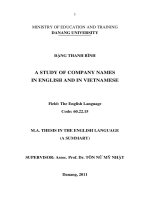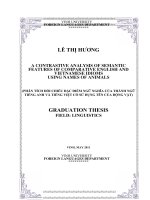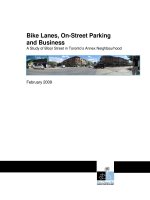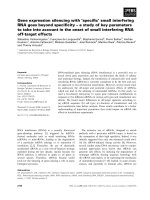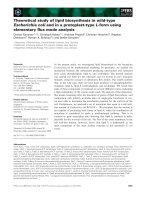Study of haematological parameters in pre and post-treated dogs with chemotherapy by doxorubicin and vincristine in canine transmissible venereal tumour
Bạn đang xem bản rút gọn của tài liệu. Xem và tải ngay bản đầy đủ của tài liệu tại đây (161.57 KB, 6 trang )
Int.J.Curr.Microbiol.App.Sci (2018) 7(11): 2732-2737
International Journal of Current Microbiology and Applied Sciences
ISSN: 2319-7706 Volume 7 Number 11 (2018)
Journal homepage:
Original Research Article
/>
Study of Haematological Parameters in Pre and Post-Treated
Dogs with Chemotherapy by Doxorubicin and Vincristine in
Canine Transmissible Venereal Tumour
Anup Yadav1, Praveen Kumar2*, N.S. Bugalia1, Umed Singh Mehra1,
Rajendra Yadav3 and Pankaj Kumar4
1
Department of Veterinary Gynaecology and Obstetrics 2Department of Veterinary Medicine
(LUVAS, Hisar), Haryana, India
3
RVDEC, Mahendergarh (LUVAS, Hisar), Haryana, India
4
Disease Investigation Laboratory, Rohtak (LUVAS, Hisar), Haryana, India
*Corresponding author
ABSTRACT
Keywords
Doxorubicin, Vincristine,
Transmissible venereal
tumour
Article Info
Accepted:
22 October 2018
Available Online:
10 November 2018
The present study was carried out in twenty-four dogs irrespective of age, breed, sex
affected with canine transmissible venereal tumour (TVT). Affected dogs were divided
equally into three groups viz. vincristine therapy (Group I) with 7 day cycle and
doxorubicin therapy consisting two groups i.e. Group II with 14 day cycle and group III
with 21 day cycle. Pre treatment blood sample collection was done before administration
of drug i.e. Day 0, 7, 14 in Group I, Day 0, 14, 28 in Group II and Day 0, 21, 42 in Group
III. Hematological parameters viz. Haemoglobin, Total erythrocytes count (TEC) and
Total luecocyte count (TLC) was undertaken for study. Non-significant but declining trend
of Hb concentration, leucopenia and reduction in total erythrocytes count was observed
post treatment in Doxorobucin and vincristine chemotherapy.
Introduction
Canine transmissible venereal tumour (TVT)
popularly called as venereal granuloma is the
longest-lived cancer 'clone' recorded in
literature. Russian veterinarian Nowinsky
described TVT in year1876 in canines. The
tumor contradicts the current view that cancer
cells generate more mutations and inevitably
become more aggressive if untreated (Murgia
et al., 2006). Transmission of TVT occurs by
direct contact through coitus and tumour cells
are seeded onto mucous membrane (Bloom,
1954 and Dass, 1986). Chemotherapy has
been shown to be the most effective and
practical therapy, with vincristine sulfate
being the most frequently used drug (Calvet et
al., 1982). TVT responds well with
Vincristine as a chemotherapeutic agent
(Cohen., 1985 and Johnston., 1994). Four to
five cycles administered at weekly interval
usually ensures a complete cure. Other
chemotherapeutic
agents
like
cyclophosphamide,
vinblastine
and
methotrexate have also been used alone or in
combination
in
treatment
regimen
2732
Int.J.Curr.Microbiol.App.Sci (2018) 7(11): 2732-2737
(Richardson, 1981., Johnston, 1991., Brown et
al., 1981; Yang et al., 1991). Resistant cases
of these drugs (cyclophosphamide, vincristine
sulphate, vinblastine and methotrexate) can be
treated with doxorubicin (Richardson., 1981;
Souza et al., 1998). Haemoglobin decline in
TVT affected dogs following chemotherapy
was consequential to bone marrow
suppressive effect of cytotoxic drugs affecting
erythropoiesis (Satoskar et al., 1995; Sandhu,
H.S. and Rampal, S., 2006).
Precursor cells of the bone marrow are
suppressed by cytotoxic drugs resulting in
reduced production of leucocytes. Decreased
TLC values following chemotherapy with
vincristine and doxorubicinin dogs affected
with TVT was due to potent myelo
suppressive action of these drugs and hence
distinct leucopenia observed (Sandhu and
Rampal, 2006). Decreased TEC values
following chemotherapy in TVT affected dogs
were due to suppression of erythropoiesis in
bone marrow (Theilen and Madewell, 1979
and Dinesh et al., 1993).
Materials and Methods
Twenty four dogs (male and female) with
history of bleeding from genital organs were
selected. Blood samples were collected from
the distal cephalic vein or saphenous vein of
male and female dogs from all three groups.
Blood samples were collected on day of
treatment before administration of drug. Site
of blood collection was shaved and cleaned
with antiseptic and 2 ml blood was collected
by using 20 and 22 or 24 gauge scalp vein set
in heparinized glass tubes for complete blood
count (CBC). Hematological parameters viz.
Total erythrocytes count (TEC) and Total
luecocyte count (TLC) were done by standard
methods. Haemoglobin was estimated by
using Sahli's haemoglobinometer. CBC
analysis was performed on day of drug
administration.
Results and Discussion
Haemoglobin (Hb)
TVT affected dogs treated with vincristine
sulphate showed marginal decreasing trend of
Hb from Day 0 to Day 14 post treatment but
Hb value were within the normal range
(Group I). Recorded declining pattern of Hb
during post-treatment period in vincristine
group simulates with the earlier observations
(Padile et al., 1998).
Dogs treated with doxorubicin hydrochloride
also registered slight decreasing pattern of Hb
during post treatment period. Haemoglobin
(Hb) values were within the normal
physiological range in both treatment
regimens of doxorubicin (Group II & III).
However, Talker (2001) also reported gradual
reduction in Hb with doxorubicin therapy in
TVT affected dogs but within normal range.
Satoskar et al., (1995) observed small sized
rubric
blast
(immature
rubriblast)
consequential to reduction of erythropoietin
level. The observed declining pattern of Hb in
TVT affected dogs following vincristine
sulphate and doxorubicin hydrochloride
therapy was consequential to bone marrow
suppressive effect of cytotoxic drugs affecting
erythropoiesis (Satoskar et al., 1995; Sandhu,
H.S., Rampal, S., 2006) (Fig. 1 and Table 1).
Total leucocyte Count (TLC)
Vincristine therapy in TVT affected dogs
registered continuous decreasing pattern of
TLC during post-treatment period. Recorded
post-treatment leucopenia in this group
concurs with the earlier observations in canine
TVT after vincristine therapy (Calvert et al.,
1982; Zezza et al., 1996 and Padile et al.,
1998). However, Coppoc et al., (1982)
reported that TLC values were not affected
with Vincristine therapy.
2733
Int.J.Curr.Microbiol.App.Sci (2018) 7(11): 2732-2737
Table.1 Hematological parameters (Mean±S.E.) in TVT affected dogs during pre and post
Treatment period (Groups I, II & III)
Parameter
Group I (vincristine)
(n=8)
Group II (doxorubicin)
(n=8)
Group III
(doxorubicin)
(n=8)
Day 0 Day 7 Day14 Day 0 Day14 Day28 Day 0 Day21 Day42
(1st
(2nd
(3rd
(1st
(2nd
(1st
(2nd
(3rd
dose) dose) dose) dose) dose)
dose) dose) dose)
14.12± 13.53± 12.95± 13.24± 12.88± 12.70± 13.32± 12.88± 12.59±
Hb(gm/dl)
0.42
0.47
0.43
0.37
0.32
0.29
0.66
0.59
0.63
TLC(thousand/cumm) 19.22± 18.38± 18.32± 18.14± 16.60± 15.11± 17.70± 16.60± 14.02±
1.80
1.88
2.07
1.34
1.40
1.22
1.58
1.40
9.84
6.92± 6.73± 6.38± 7.44± 7.18± 6.70± 7.08± 6.58± 6.30±
TEC(million/cumm)
0.23
0.15
0.18
0.10 a 0.04 a 0.12 b 0.18 a 0.14 b 0.15 b
Day 0- pretreatment period; Days 7, 14, 28, 21, 42- post-treatment period
Means with different superscripts (a, b) within the group in a row differ significantly (p<0.05)
Fig.1 Histogram showing haemoglobin values (Mean±S.E.)in TVT affected dogs during pre- and
post-treament period (Groups I, II & III)
Dogs treated with doxorubicin regimen also
showed gradual but non-significant declining
trend during post-treatment period. Similarly,
marginal leucopenia was recorded following
doxorubicin therapy in TVT affected dogs
(Benjamin, 1979).
However, Todorova et al., (2005) reported
significant leucopenia in dogs after
administration of second dose of Doxorubicin
hydrochloride. Dobson and Gorman (1993)
reported that cytotoxic drugs suppress the
replicating precursor cells of the bone marrow
resulting in reduced production of leucocytes.
Recorded decreased TLC values following
vincristine and doxorubicin therapy in dogs
affected with TVT was due to potent myelo
2734
Int.J.Curr.Microbiol.App.Sci (2018) 7(11): 2732-2737
suppressive action of vincristine and
doxorubicin and hence distinct leucopenia
observed (Sandhu and Rampal, 2006).
future reference early diagnosis, timely and
cost effective treatment strategy must be
adopted to control this sexually transmitted
disease.
Total erythrocyte count (TEC)
References
Consistent non-significant decreasing trend of
TEC was observed in TVT affected dogs
during post-treatment period of vincristine
sulphate and values remained within normal
range from Day 0 to Day 14.
Dogs treated with doxorubicin regimens
(Group II & III) showed significant fall in
TEC values during post-treatment period but
within the normal range. Similarly, Todorova
et al., (2005) and Gadmade (2006) recorded
significant reduction in TEC following
Doxorubicin hydrochloride therapy.
Decreased TEC following chemotherapy in
TVT dogs was due to suppression of
erythropoiesis in bone marrow (Theilen and
Madewell, 1979 and Dinesh et al., 1993).
Jumean et al., (2006) suggested that
erythrocytic cell abnormalities are also
observed invinca alkaloid toxicity.
Non-significant declining trend was observed
in Hb, TLC and TEC following vincristine
therapy (Group I) and doxorubicin therapy
(Group II and III).
In conclusion, venereal tumour problem is
still very important disease in sexually active
population of straydogs because of its
sexually transmitting nature and its incidence
is rapidly growing in tropical subtropical
areas including India.
Although its clinical signs and symptoms are
much indicate of its diagnosis but continuous
blood loss, immune-suppression and bone
marrow depression by chemotheurapeutic
drugs viz. Vincristine and Doxorubicin
caused decline in Hb, TLC,TEC values. So in
Benjamin, M.M. (1979). Haematology
Outline
of
Veterinary
Clinical
Pathology 3 edn. lowa State Univ Press'
Ames, lowa. PP: 75-94.
Bloom, F. (1954). Pathology of Dog and cat.
(American
Veterinary
Publication
Eastern lllinois), 275.
Boscos, C., Ververidis. H.N., Stefanakis, A.,
Saratsis, P., Stamou, A.I., &
Krambovitis,
E.
(2004).
Serum
oestradiol-17β,
progesterone
and
respective
cytosol
receptor
concentrations
in
bitches
with
spontaneous pyometra. Theriogenology
62, 614-623.
Brown N.O., MacEwen E.G., Calvert C.A.
(1981). Transmissible venereal tumor in
the dog. California Vet; 3:6-10.
Calvert, C.A., Leifer, C.E. and MacEwen,
E.G. (1982). Vincristine for treatment of
transmissible venereal tumours in the
dog. J. of the Am.Vet.Med. Assoc., 181:
163-164
Cohen D. (1985). The canine transmissible
venereal tumor: A unique result of
tumor progression. Adv Cancer Res;
43:75-112.
Coppoc, G. L. (1982). Chemotherapy of
neoplastic
diseases
in
Johnes
Veterinary: Pharmacology, By Booth N.
H. and Mc. Donald.5th Edition pp789793.
Dass, L.L., Sayay, P.N., Khan, A.A., and Jha,
G.J., (1986). Malignant transmissible
venereal tumour. Canine Practice,
13:15-18.
Dinesh, N.M.; Rangnath, B.N., Jayadevappa,
S.M., and Srinivas, C.L. (1993).Gross
and
microscopic
changes
in
2735
Int.J.Curr.Microbiol.App.Sci (2018) 7(11): 2732-2737
transmissible venereal tumour following
vincristine sulphate therapy. lnd Vet J.
70(7):609-611.
Dobson, J. M., and Gorman, N.T. (1993),
Cancer chemotherapy in small animal
practice.
Blackwell
scientific
publication London: 67-154.
Gadmade. (2006). Studies on unusual vaginal
tumours in bitches with special
Reference in bitches with special
reference to therapeutic measures.
M.V.Sc. thesis work submitted to
Maharashtra Animal & Fishery.
Johnson, C.A. (1994). Infecçõesgenitais e
tumor venéreotransmissível. In: Nelson
RW, Couto CG, eds. Fundamentos de
MedicinaInterna de PequenosAnimais.
Rio de Janeiro: Guanabara Koogan;
525.
Johnston S.D. (1991). Performing a complete
canine semen evaluation in a small
animal hospital. Vet Clin North Am
Small AnPract; 21(3):545-551.
Jumean, H. G.; Camitta, B., Holcenberg, J.
and Hodach, A. (2006). Desacetyl
Vinblastine amide sulfate induced
erythropoiesis Cancer 44(1): 64-68.
Murgia, C., Pritchard, J.K., Kim, S.Y.,
Fassati, A. and Weiss, R.A. (2006).
Clonal origin and evolution of a
transmissible cancer. Cell, 126: 477487.
Novinsky,
L.
C.
(1876).
Tumor
transplantation studies in dog. A report
of l0 cases and a review of literature.
Journal of comparative Pathology 96(6):
623-635.
Oser, B.L. (1965). Blood analysis of Hawk’s
Physiological Chemistry, 14th Edition,
McGraw Hill Publishing Company,
New York; 975-1152.
Padile, R. D., Panchbhai, V.S., Bhokre, A.P.,
Jadhav, P.T., and Bapat, S.T. (1998).
Heaematological and blood biochemical
changes in dog after vincristine
administration for treatment of venereal
granuloma. Ind. J. of Vet. Surg. 1:47.
Richardson,
R.C.
(1981).
Canine
transmissible venereal tumour. Comp
ContinEducPract Vet; 3:951-956.
Sandhu, H.S., Rampal, S., (2006). Essentials
of Veterinary Pharmacology and
Therapeutics First Edition pp: 13591381.
Satoskar, R.S., Bhandarkar S.D. and
Airnapure S. S. (1995). Pharmacology
and Pharmaco therapeutics revised
Fourteenth Edition.734.
Souza, F.F., de, Tinucci-Costa, M., FariaJr, D
(1998). Doxorubicin treatment for
recurrent canine transmissible veneral
tumor. In: Proceedings of the XXIII
Congress of the World Small Anim Vet
Assoc; 772.
Talekar, S.H. (2001). Comparative study of
surgical excision and chemotherapeutic
agents in the treatment of mammary
tumours in canine. Unpublished
M.V.Sc, thesis submitted to the Dr
Punjabrao
Deshmukh
Krishi
Vidyapeeth, Akola.
Theilen, G.H. and Madewell, B.R.
(1987).Veterinary Cancer Medicine.
Clinical
Application
of
Cancer
Chemotherapy, 2nd edn, (Lea and
Febiger, Philadelphia), 183-196.
Tinucci-Costa,
M.
(1999).
Tumor
venéreotransmissível:
estudosimunohistoquímicos
e
de
transplantaçõesxenogênicas
e
alogênicas. Ph D Thesis Faculty of
Medicine. San Pablo University,
RibeirãoPreto, 1999; 144.
Todorova, G., Simeonov, R. and Dinev, D.
(2005). Efficacy and toxicity of
doxorubicin and cyclophosphamide
chemotherapy in dogs with spontaneous
mammary tumors. Trakia j. of sci. 3:5158.
Yang, T.J., Palker, T.J., Harding, M.W.
(1991).
Tumor
size,
leukocyte
2736
Int.J.Curr.Microbiol.App.Sci (2018) 7(11): 2732-2737
adherence inhibition and serum levels
of tumor antigen in dogs with the canine
transmissible venereal sarcoma. Cancer
Immunol. Immunoth, 33:255-256.
Zezzaet, N. L., Polegato, E.P., Dos, S. and
Peres, J. A. (1996). Treatment of the
sticker tumour (Transmissible venereal
tumour) with oncovin. Vet.Bull., 66:
148
How to cite this article:
Anup Yadav, Praveen Kumar, N.S. Bugalia, Umed Singh Mehra, Rajendra Yadav and Pankaj
Kumar. 2018. Study of Haematological Parameters in Pre and Post-Treated Dogs with
Chemotherapy by Doxorubicin and Vincristine in Canine Transmissible Venereal Tumour.
Int.J.Curr.Microbiol.App.Sci. 7(11): 2732-2737. doi: />
2737
